Greetings from Chicagoland
Greetings from Chicagoland. Dan’s MEGA65 Digest for September 2024.

It’s a busy month! I just got back from the Vintage Computer Festival Midwest (VCFMW), the large-and-getting-larger-every-year vintage computer show. This was my first visit at this particular show, and it was great fun. I bring back a few photos, a few stories, and too much stuff from the free table.
But first, the news.
Catching up on pre-orders; mainboards now available separately
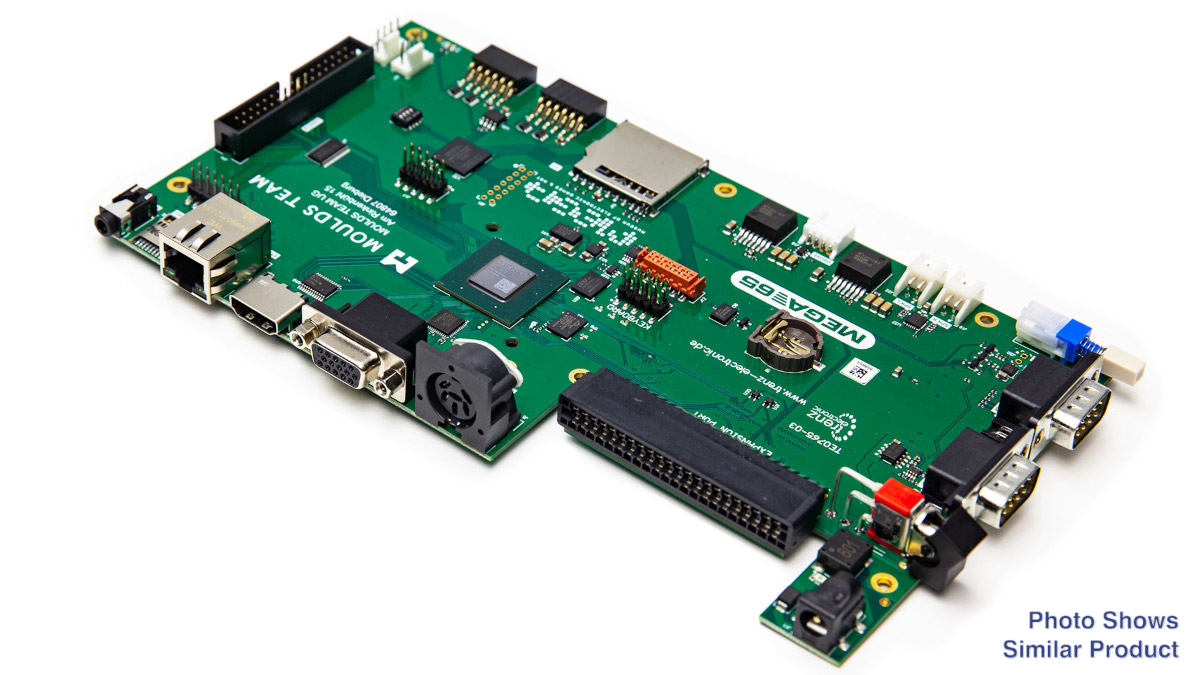
The MEGA65 mainboard, now available separately
Trenz Electronic is making steady progress on shipping all of the pending MEGA65 preorders, on schedule to get everyone taken care of by the end of the calendar year. A new pre-order for a MEGA65 placed today should have a lead time of only a few months. If you placed a pre-order and have received an email with an invoice, be sure to submit payment promptly. Invoiced but unpaid orders expire within a few weeks, to allocate inventory to others waiting on a pre-order. (Thankfully, you can just re-make your expired order, and you’ll receive it fairly soon.)
With this milestone comes some exciting news! Trenz Electronic is now accepting preorders for MEGA65 mainboards without the enclosure, keyboard, or floppy drive. This is great for electronics projects, custom enclosures, or just keeping a spare. You can make your own keyboard with some effort, and the floppy drive is a standard IDE drive and cable. The standalone mainboards are expected to ship in mid-2025.
Many owners of the 2022 edition of the MEGA65 (mainboard revision R3A) asked for the ability to replace the mainboard with the latest hardware revision (R6), and it’s great that Trenz is providing this option. This is just my opinion, but if you simply want a MEGA65 with the revised hardware, you might get a better result buying a complete new computer, and selling your 2022 edition on the secondary market. The mainboard is more than half the cost of the computer, and unless you want to keep the spare R3 board, you’re unlikely to recoup that cost after an upgrade. Of course, there are no guarantees on the secondary market, but it’s worth giving it a thought. Personally, I own two MEGA65s and a spare board, a Nexys dev board—and dozens of other computers. But you might not want to follow my example.
Speaking of owning lots of computers, Trenz has lifted the one-per-person limitation on MEGA65 pre-orders. If you want to outfit a classroom, hand out MEGA65s at parties, or just make a cool fort out of the boxes, now is your chance!
Thanks as always to everyone at Trenz Electronic for their partnership on the MEGA65 project.
Filehost messaging feature

Filehost new message notification
Filehost, our community file and information sharing board, has a new feature! You can now receive private notifications from the system, and send and receive private messages with other users. If you have a pending notification or incoming message, a red dot will appear on the user icon in the upper right corner.
To receive incoming notifications and messages, you must enable them: go to User menu > User Settings, check “Allow to receive messages from users” and “Inform me about comments on my entries,” then click Submit.

Filehost message settings
To access your messages: User menu > Messages.
To start a new private conversation with another user: click the plus sign next to Subjects, select the user, enter a subject, then enter the first message. Only users who have enabled incoming messages appear in the list of users.

Starting a new conversation
To add to an existing conversation: select the subject from the list, then scroll to the bottom of the conversation and enter the next message.
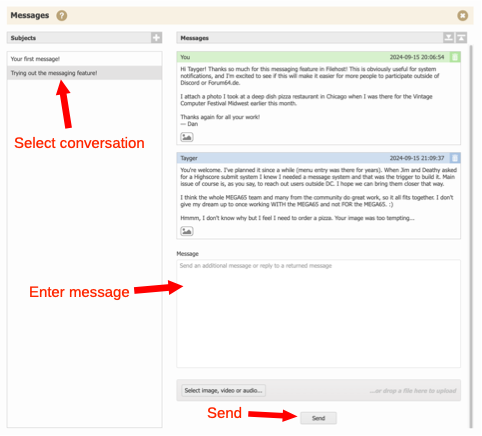
Adding to an existing conversation
Huge thanks to Tayger for this new feature, and all of his work on this essential community resource!
New C64 core documentation
Boris has been working on extended documentation for the C64 core. The docs are now “feature complete,” with coverage of every feature and common task, including how to install JiffyDOS or use the built-in RAM expansion unit (REU). Be sure to send Boris your feedback and thanks, via Discord or email. Thank you, Boris!
Recent Filehost uploads
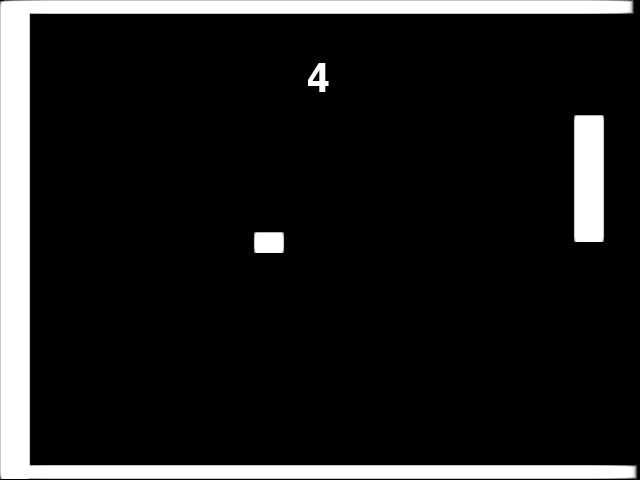
Pelota, a single-player paddle game, by SirLazarus
A few recent Filehost uploads for you to try:
- Quadratic Equation Solver, by fredrikr, an equation root finder
- 3D 4-in-a-row, by fredrikr, a 4x4x4 two-player tile placement game
- Pelota, by SirLazarus, a single-player paddle game; requires a recent ROM beta
- Hang the DJ, by mk9, a Hangman-style word game
- romlister, by nobruinfo, a small utility to list which ROMs you have on your SD card
Greetings from Chicagoland!
I just flew back from Vintage Computer Festival Midwest and boy are my arms tired. Literally. I took my MEGA65, printed table displays, a bunch of backup equipment, and bundles of 45GS02 mousepads to give away. I use this weatherproof hard case when I travel with my MEGA65, and I always carry it onto the plane and put it in the overhead bin. For this trip, the less delicate stuff went into a large checked bag. Who knew 100 mousepads would be so heavy! Thankfully, everything made it there and back safely.
The event took place at the Renaissance Schaumburg Convention Center Hotel, in Schaumburg, Illinois, in the Chicagoland area. The show consumed an entire expo floor and a separate presentation space for talks. This venue is also a nice hotel, and many exhibitors and visitors stayed here or in a nearby Embassy Suites. I didn’t take enough photos to do justice to the scale of this show, but hopefully you can get a sense of it.

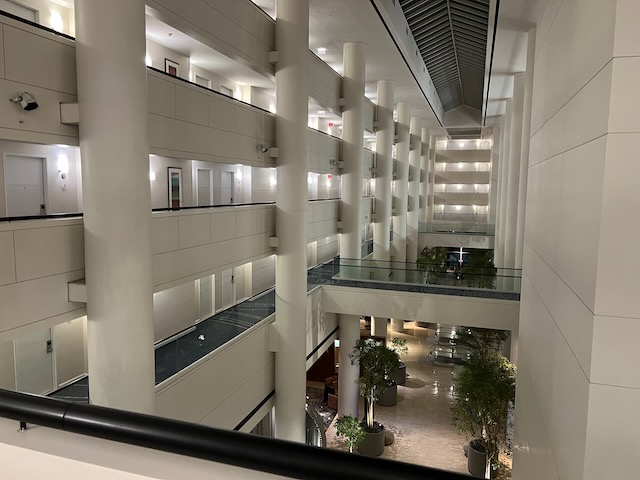
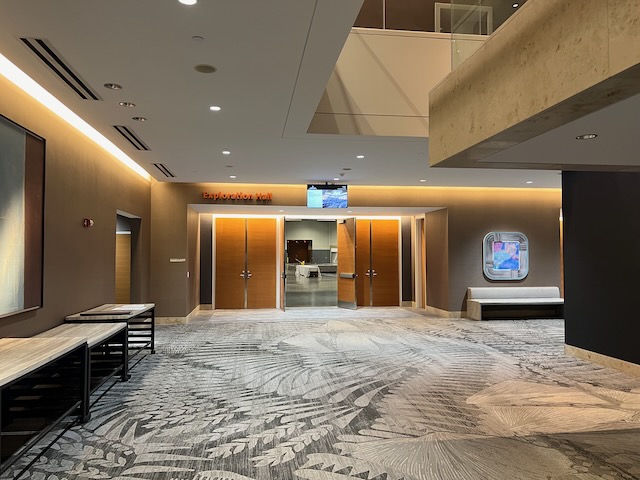
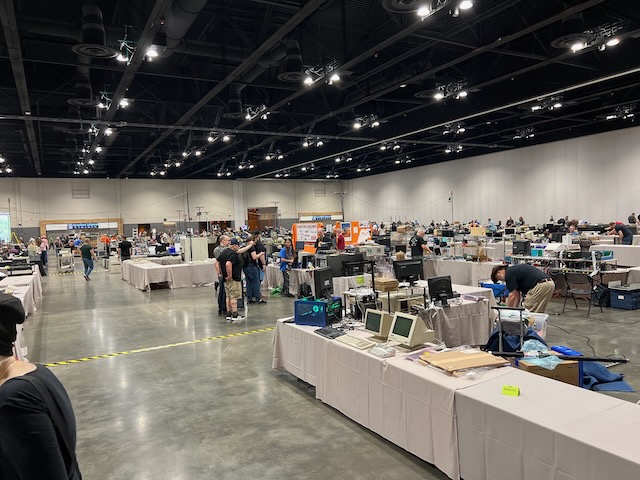
I prepared a bunch of table tchotchkes, more than I actually needed, including a colorful banner, an informational standee, a “demo” booklet that someone could use to launch and browse software on the SD card, and various boxed software and accessories. I didn’t have a good way to hang the banner, so it ended up being more of a tablecloth, but it still added some color. I also made business cards with a full-color photo on one side and links to resources on the other. And a custom t-shirt to wear, because why not.
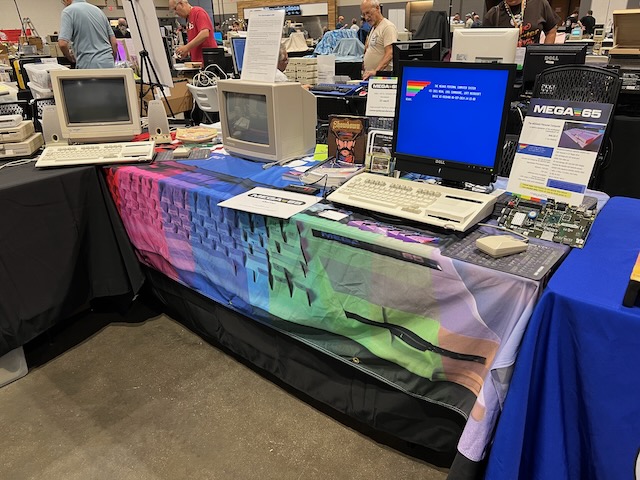
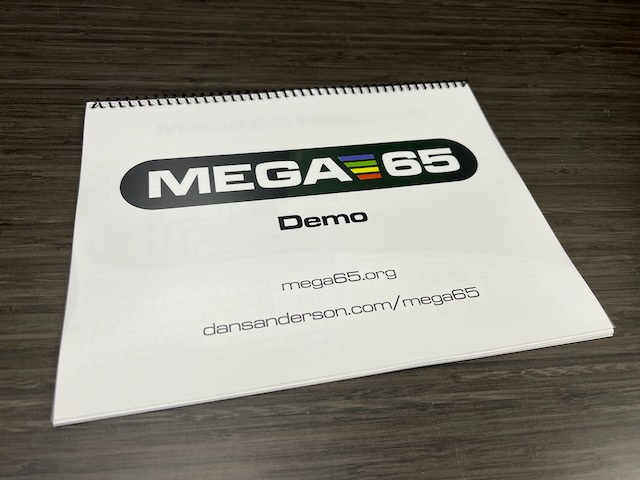
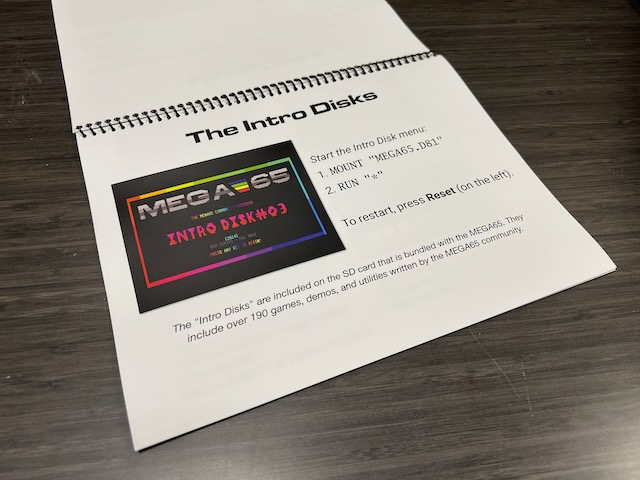

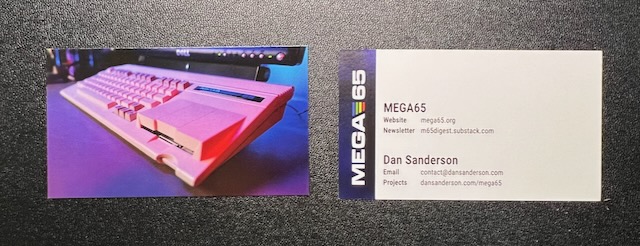
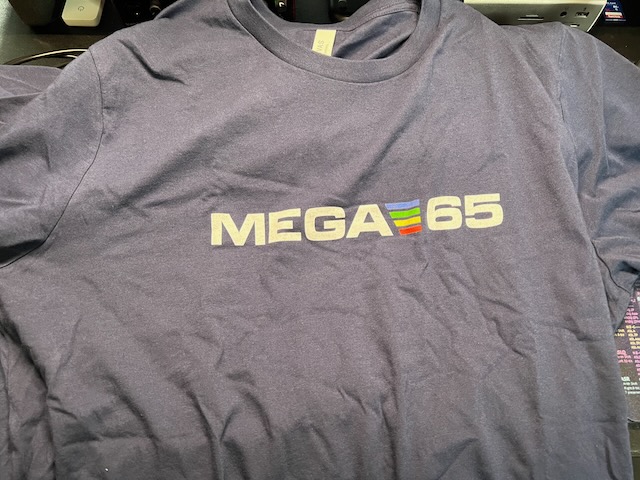
Ladies and gentlemen: the Commodore 65
My table included my MEGA65, Jim Happel’s MEGA65, and two original Commodore 65 prototypes owned by Jim Brain. After having been on the MEGA65 project for two years, it was a real thrill to be able to see a C65 prototype and the MEGA65 side by side. It was also the best conversation starter: most passersby knew the C64 and never heard of the C65, so I could just point to the C65 first, then tell the rest of the story. Several people knew of the C65 and were excited to see it in person, taking selfies with the computer. I took a bunch of photos myself for future reference.
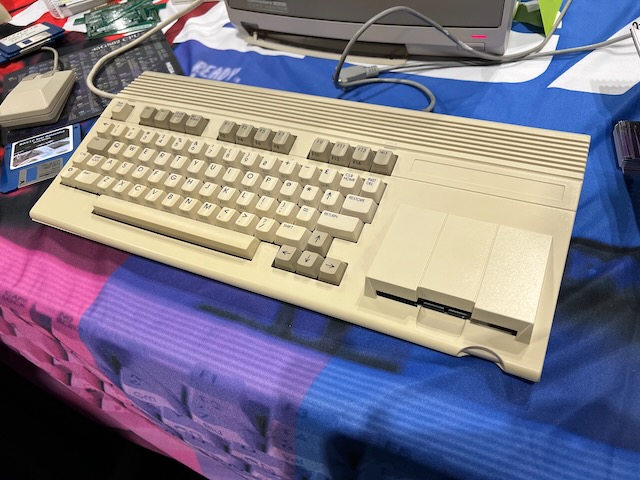
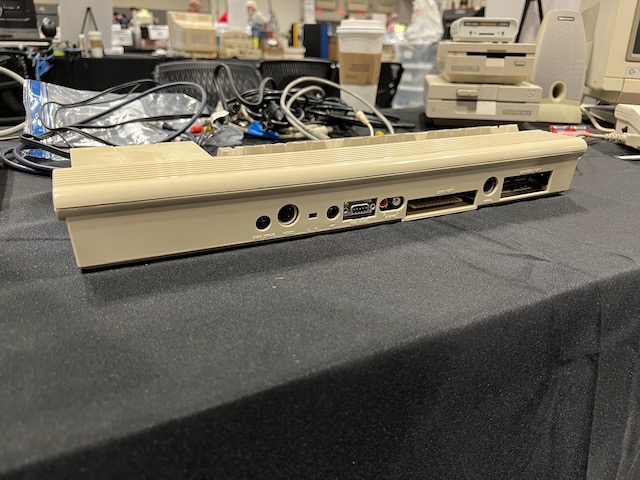
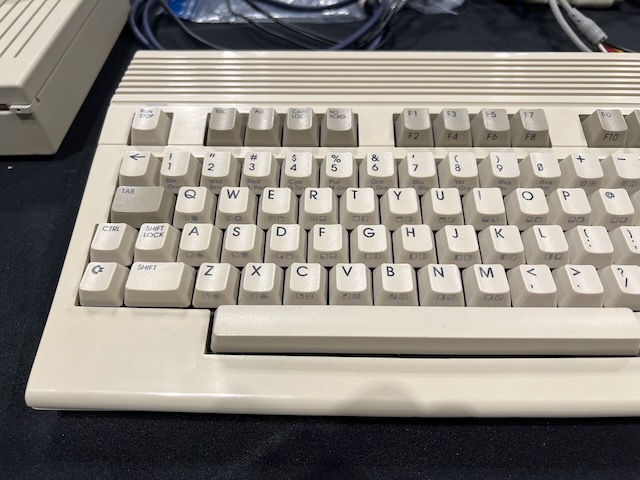
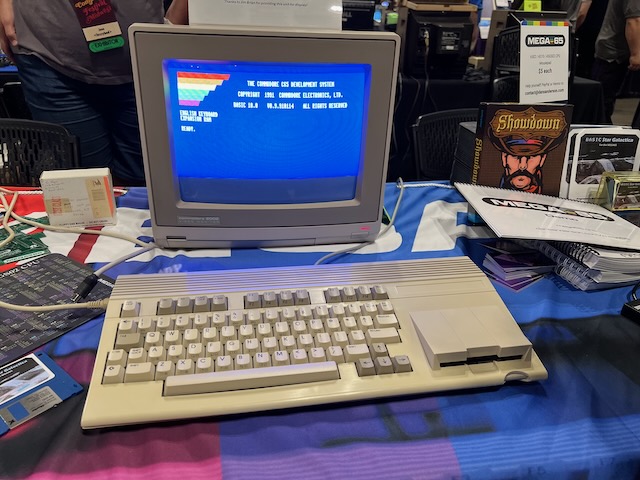
I tried to spend some time with Jim Brain’s copies of the demo disks, both on the C65 and on the MEGA65. It was a sobering reminder of how the C65 prototypes were not ready to be software platforms that the demo disks were hard-coded to specific versions of the ROM. Disks were generally not working on the C65. I could list directories but not load files. I got the IFF slideshow disk to work on the MEGA65—and of course I forgot about the topless woman until it showed up right as some young kids were walking up to the table.
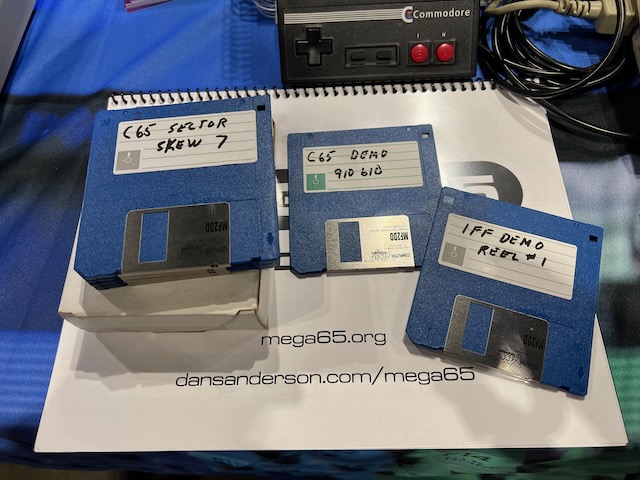
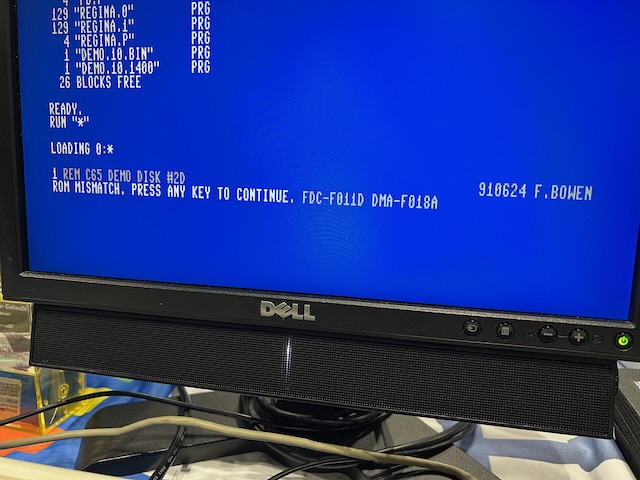
One especially fun find was a message that Fred Bowen posted to the comp.sys.cbm Usenet group on September 17, 1993, subject line, “What’s a C-65???” Fred’s message puts the date of the liquidation sale around July 1993, and claims the prototypes numbered around 50. (According to Brian Bagnall’s Commodore: The Final Years, “By 1991, Commodore had at least 205 pilot production C65 machines. ‘We had a room full of them at one point,’ says [chip designer Bill] Gardei. ‘If you counted all the variants, 205 would not be an unreasonable guess.’”) In the message that follows, “Grapevine” refers to The Grapevine Group Inc. of Suffern, New York, one of two companies known to have acquired and re-sold the prototypes.

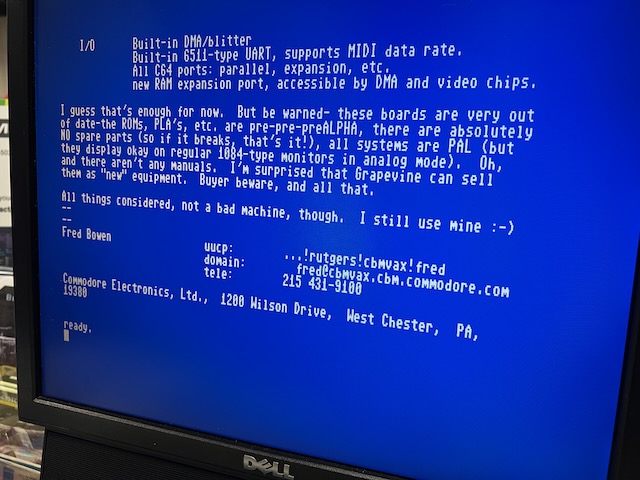
From:
fred@cbmvax.cbm.commodore.com(Fred Bowen)
Newsgroups: comp.sys.cbm
Subject: Re: What’s a C-65???
Date: 17 Sep 93 14:56:25 GMT
…Apparently Grapevine picked up some C65’s during Commodore’s liquidation of its warehouse/storage areas a couple of months ago.
What is a C65? A product that almost made it out the door. What you’re seeing are “alpha” pilot-production units. There were only something like 50 units made, and a dozen or more of these were distributed around engineering, system developers, etc. Obviously, they were never meant to be sold to the public, but…
CPU CSG65CE02, running at 3.54MHz
RAM 128K, expansion to ~8MB
ROM 128K, including C65 mode (v10.0), C64 (v2.2) mode, & DOS
Video CSG4567 “VIC-III”
I/O Built-in DMA/blitter
Built-in 6511-type UART, supports MIDI data rate.
All C64 ports: parallel, expansion, etc.
new RAM expansion port, accessible by DMA and video chips.I guess that’s enough for now. But be warned- these boards are very out of date-the ROMs, PLA’s, etc. are pre-pre-preALPHA, there are absolutely NO spare parts (so if it breaks, that’s it!), all systems are PAL (but they display okay on regular 1084-type monitors in analog mode). Oh, and there aren’t any manuals. I’m surprised that Grapevine can sell them as “new” equipment. Buyer beware, and all that.
All things considered, not a bad machine, though. I still use mine :-)
At some point during the conference, some guy I’d never met showed up at the table and started opening the C65 case. I politely but firmly discouraged him from touching it without Jim Brain’s permission. The guy smiled and introduced himself as Jim Brain. 😅 We were having some difficulty with non-functioning keys on one of the C65s, and Jim noticed a small break in the keyboard ribbon cable that will need repair. Thankfully, and amazingly, Jim has two C65s, so we temporarily swapped the keyboards to form a fully functioning unit. Jim was careful to keep track of the fact that we swapped the keyboards, so they could be reunited with their original cases later.
The C65 prototype is held together with one screw in the front-right of the case near the floppy drive. The rest of the case is all plastic tabs, to make it easy to open and repair. I got to see and photograph the internals of both machines. Developer unit #23 contained the revision 2A mainboard, and a memory expansion module.
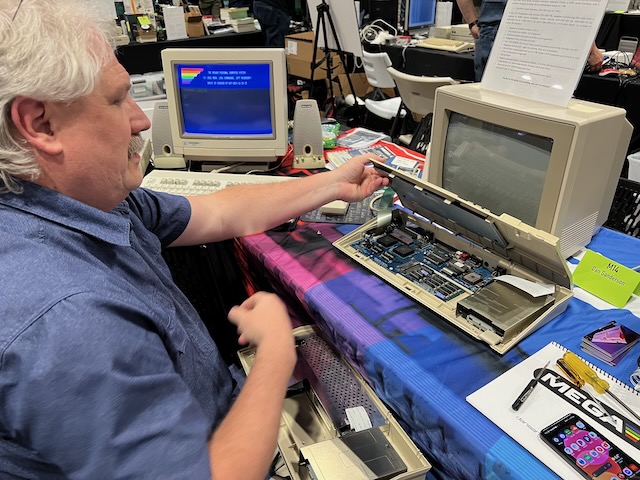
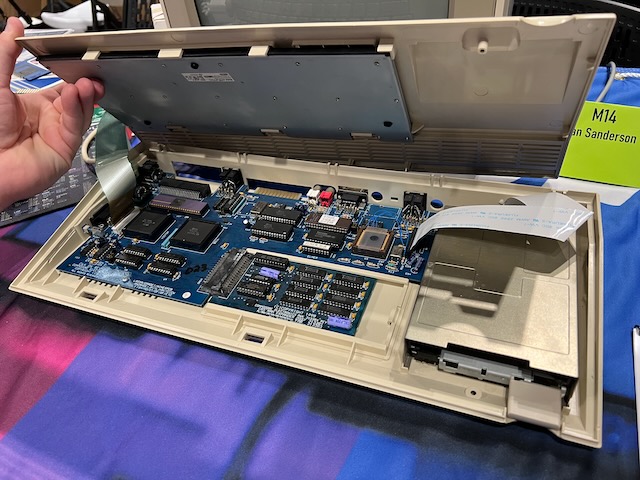
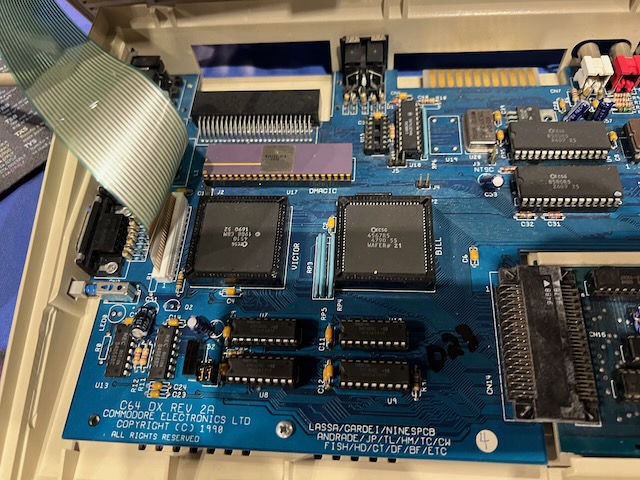
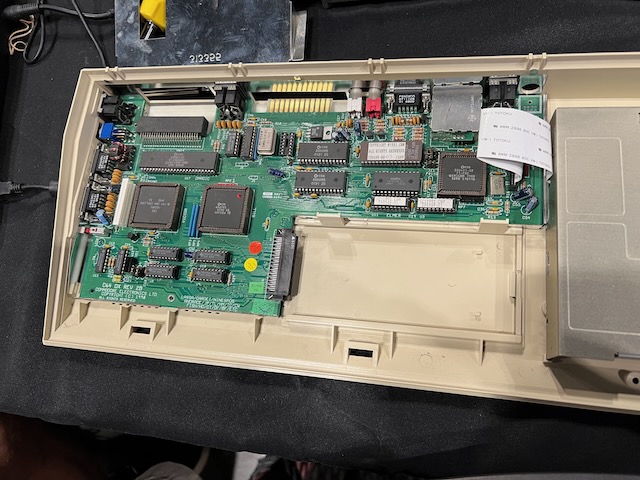
As impressive as the C65 is as a historical artifact, I’m relieved to realize that I don’t want to own one. Not that that was ever an option, with working units selling on eBay for $30,000. A recent auction for a broken one ended north of $12,000. The prototype plastic is weird, the keyboards are mushy compared to a good condition production C128, and the working ones barely work and are difficult to maintain. I’m grateful for collectors like Jim for keeping them alive as long as possible and sharing them with the world. And I’m grateful for the MEGA65 for not only letting me access a piece of this history in my own home, but for being a satisfying instrument of recreational computing in its own right.
Reactions
Quite a few people saw the READY. prompt and wanted to type their own GOTO 10 program. Several young kids took the time to write a longer program, though they did it all from memory and didn’t bother exploring the manual. I ended up standing in front of the table and doing guided demos for most of the time. First Shot, Maniac Mansion, and Unicone attracted attention. Nobody bothered with the “demo” booklet, even with encouragement. I’m still glad I made the demo book: the full-color screenshots made it something you could flip through in seconds, and get a glimpse without having to wait for software to load.
I had stacks of the mousepads on the table. At first I was concerned that if I gave away the mousepads for free that they would disappear quickly, and wouldn’t provide much promotional value, so I had intended to maybe sell them at cost, and even made a little for-sale sign for it. I figured out within the first few hours that this wasn’t going to be a problem. I took down my for-sale sign and just arbitrarily handed mousepads to people that seemed even remotely interested in programming. At the end of the last day, I ran around the floor looking for coders I admired by reputation, and used mousepad gifts as excuses to say hi.
I had many good conversations with many people with a wide variety of interests and backgrounds, and I handed out many business cards. Greetz to all the new newsletter subscribers!
Expo highlights
Many of the Commodore exhibits were colocated together in a common section. There ended up being so much diversity in the exhibits that you almost couldn’t tell they were related by platform. I was delighted that my table was next to the brilliant CityXen, who were showing off “Whackadoodle,” their C64-powered whack-a-mole game with giant colorful light-up arcade controller, along with a miniature version with custom handheld controllers.
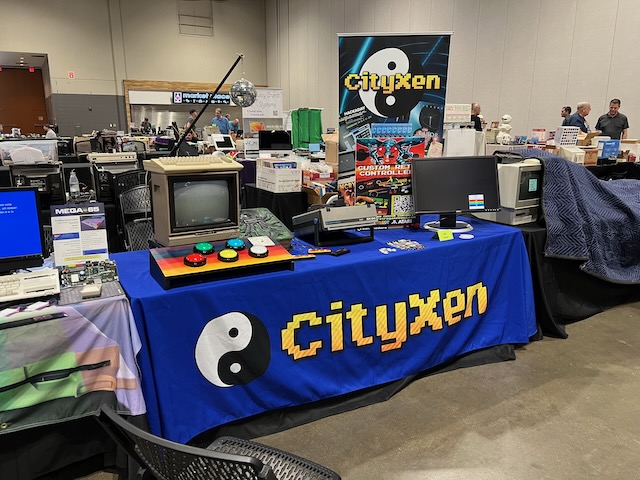
June of the excellent Nybbles & Bytes was also in my area, demoing and distributing her unique C128 game, Nybbles: Legend of the Drunken Snake. When you first start playing, Nybbles looks like a traditional snake game, until just moments later you eat something unusual and things get utterly wild. The game uses two displays, and manipulates both the VIC-II and the VDC in ways I have never seen before. I waited to the end of the show to buy one to give others a chance, and I did indeed end up with one of the last copies to be distributed on floppy disk. Be sure to subscribe to the Nybbles & Bytes YouTube channel for future updates and technical details about the game.
Right around the corner, I met Craig of BitBinders, maker of 1581 clone floppy disk drives. I was especially impressed by his unique dual drive units, available in both vertically and horizontally arranged variants. I bought one of the horizontal units immediately. Craig already knew about the MEGA65, and we discussed the un-produced Commodore 1565 external drive, and how a modern clone would make a great MEGA65 accessory (along with the expansion board that provides the 1565 mini-DIN connector).
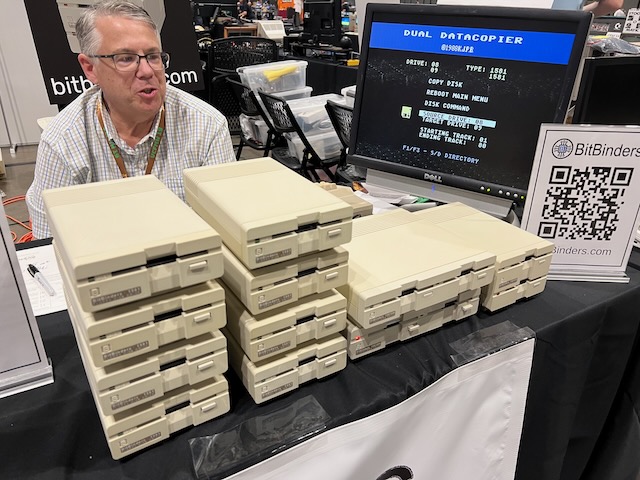
There isn’t enough space to show all the photos of cool and unusual computers I saw throughout the show, but I had such a strong reaction to this one I have to include it. I’ve wanted a Heathkit Hero 1 robot kit all of my life, having only known it through advertisements in magazines. This is the first time I’ve ever seen a Hero in person. The Hero Jr., on its 40th anniversary, was sharing a table with two Androbot Topo robots.
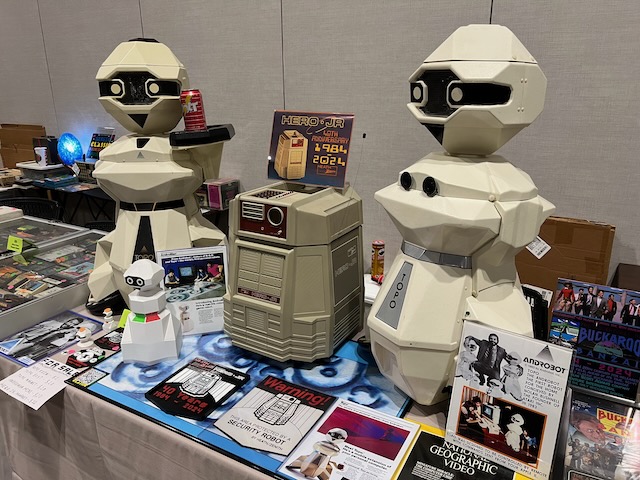
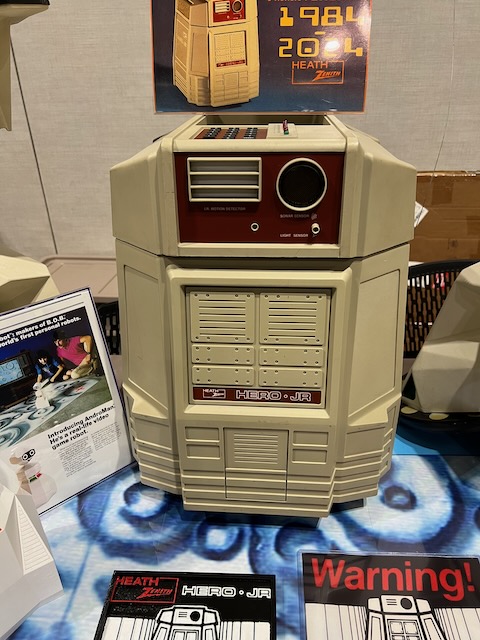
VCFMW is as much a swap meet as a share-out, and about half of the show floor was for sale. Many exhibitors had new and vintage items for sale, and VCFMW also held an auction of unusual items donated by exhibitors to help fund the event. What really gives the convention a pervasive electric air is the ominous entity known as the Free Table. People leave stuff to give away, and other people take stuff they like, a waxing and waning of trash and treasure throughout the convention. The table is largely unsupervised, which gives the added thrill of worrying that something that isn’t free might get taken. (This has happened.) The table this year was well labeled, with a useful partition between the free table and the next table over, so it was pretty chill.
I knew I was flying home, and I’m kind of at my limit for hardware anyway, so pretty much nothing on the free table interested me. I saw some ’90s-era Microsoft software in original boxes pass across the table. My big finds were all books, where at least one person was shedding a nerd’s bonanza of famous titles on computer science and programming. I grabbed what I could carry, and left behind some of my favorite books just because I know I already owned them. I was glad to see the good ones eventually found new owners.
Of course, with the bundles of mousepads, booth decor, and equipment, my luggage was already quite full and quite heavy. The books pushed my checked bag over the weight limit, and ended up costing me a $100 heavy bag fee. So not exactly free. Still a decent haul.
I owe huge thanks to Jim Happel (jim_64 on Discord) for making my VCFMW trip possible. Jim encouraged me to make the trek in the first place, and provided logistical, technical, and moral support throughout the experience. Jim also introduced me to many excellent people in the community whom I’ve known only by reputation online and I now consider friends. This was such a good time, I’m eager to visit the other annual shows around the country as time and budget allows, with my MEGA65 in its carrying case.
Thanks to everyone for your kind words and feedback on EasyAsm v0.1. I’ve only received a couple of bug reports—which just means you’re not trying hard enough to break it! I hope to start a revision as soon as I’m through this very busy month. I’m working on the draft of this year’s community survey, I’m dropping off a kid at college, and I still have the Portland Retro Gaming Expo in a couple of weeks.
Special thanks to all of my supporters, who are making my promotional tours and other projects possible. If you like what I’m doing, please consider becoming a supporter. Visit: ko-fi.com/dddaaannn

Cheers!
— Dan